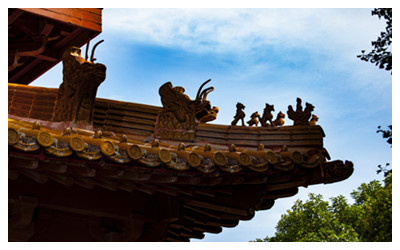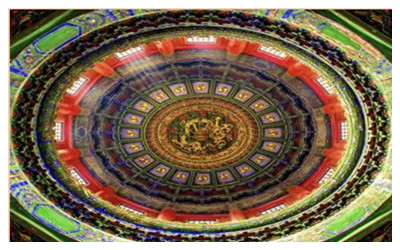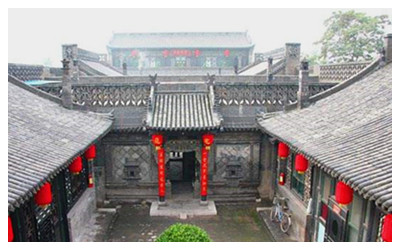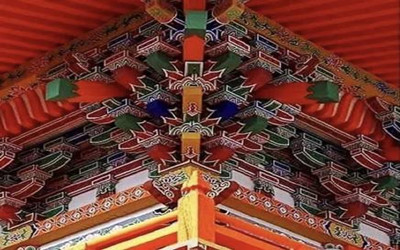It is a special component in the Chinese ancient building. The square board is called "Dou", the short bow wood is called "arch",the long inclined wood is called "Ang",and "arch" is their general name. Usually it is placed among the pillar head and forehead,face of the house to prop up a beam and pick up eaves and it also has a decorative function. It is made up of the square wood, the short bow wood and the long inclined wood, mixing in length and breadth layer upon layer and pursuing a layer to pick outwardly to form a pad base which is to descend.
It is originally for protecting wood structure against damp and corrosion and insect-eating,afterwards the press of it is just the adornment. After
Song Dynasty, the colorful paintings have become the indispensable adornment art of palace. It is divided into three grades.
A. The Hexi colorful painting 和经彩画
It is the highest colorful painting in grade. Its main characteristics are: the center of the painting is made up of various pictures of dragons or phoenix and using the flower patterns to fill the space; both sides of the paintings use 《》 to frame and daub them with some shining coating such as gilding to make them look very magnificent.
B. The circle colorful painting 旋子彩画
Its grade is next to the Hexi colorful painting. The painting uses the simplified form of flowers with the eddy petals; sometimes it can also draw dragon and phoenix. The two sides may frame with gilding powder It is generally used in the less important palace or temples.
C. The colorful painting of Su's type 苏式彩画
Its Grade is lower than the two kinds above. The picture covers landscape, person story, flowers, birds, fish, and insects..., the both sides use "《》" or " ( )" to frame. "()" is called "wrapper" by architects. The colorful painting of Su's type is developing from the "wrapper" colorful painting of the South of the Yangze River.
 Roof
Roof (called in ancient times "House Cover")
The Chinese traditional roof has the following seven kinds, the Palace Wu of the double-eave roof and the heavy summit of hill of the double-eave roof are the highest grades , and then followed with the Palace Wu of the single-eave roof and the heavy summit of hill of the single-eave roof.
A. The roof of the Palace Wu 庞殿顶
Its all sides are sloping with one positive ridge and four inclined ridges. The house's surface has a little bit radian,it is also called Four A Roof.
B. The roof of the heavy summit of hill 歇山顶
It is a combination of the roof of the Palace Wu and the hard summit of hill, which means the upper part of the house surface with four sloping sides, and turns to the triangle wall surface which is hanging straight. There are one positive ridge, four hanging ridges and four dependent ridges in it, so it is also called nine-ridge roof.
C. The roof of the hang summit of hill 悬山顶
It is that the two sides of the double ascent of the house surface stretch out the gable wall. There is a positive ridge and four hanging ridges on the house surface, so we also call it the roof of the picking-summit of hill.
D. The roof of the hard summit of hill 硬山顶
The double ascents of the house surface and two sides of the gable wall are at the same level of the house surface, or slightly higher than it.
E. The roof of the accumulating top 攒尖顶
Its flat surface is circular or polygon and it is a roof of taper up. There is no positive ridge and several house ridges hand over in the top end. This type of roof is generally used in ordinary pavilion, terraces and towers.
F. The roof of rolling shed 卷棚顶
The house surface has double ascents and there is no obvious positive ridge, that is the connection of the front and bock of the oscents building up in layers in a curved form instead of using the ridges.
Gable Wall 藻井

It is the wall which is formed as the top of mountain at the up of both sides of the house. The familiar gable wall still has the wind-fire gable wall, which has the characteristics of two sides of gable wall being higher than house surface, presenting a stairs form with the slope surface of the roof.
Decorated Ceiling Panel (Algae Well) 装饰天花板藻井
It is a kind of adornment on the ceiling in the Chinese traditional building. "Algae well" implies that the water subdues fire, which con prevent it from a fire. It is generally above the Buddha's seat of temples or the throne of the palace. Algae well is the sunken part of the even roof, there being square space form, hexagon, octagon or circular, which is engraved or colored up on it,among those pictures "double dragons play with a bead" is quite popular.

 It is also called base pedestal, which is the base of the building. Its surface is higher than ground. Base is for bolstering the building and protecting it against damp or corrosion. In the meantime, it can make up for the imperfection that the single-building in Chinese ancient architecture is insufficient in grandness and height. Generally there are four kinds of bases.
It is also called base pedestal, which is the base of the building. Its surface is higher than ground. Base is for bolstering the building and protecting it against damp or corrosion. In the meantime, it can make up for the imperfection that the single-building in Chinese ancient architecture is insufficient in grandness and height. Generally there are four kinds of bases. Arch (Dougong) 斗拱
Arch (Dougong) 斗拱 Roof (called in ancient times "House Cover")
Roof (called in ancient times "House Cover") It is the wall which is formed as the top of mountain at the up of both sides of the house. The familiar gable wall still has the wind-fire gable wall, which has the characteristics of two sides of gable wall being higher than house surface, presenting a stairs form with the slope surface of the roof.
It is the wall which is formed as the top of mountain at the up of both sides of the house. The familiar gable wall still has the wind-fire gable wall, which has the characteristics of two sides of gable wall being higher than house surface, presenting a stairs form with the slope surface of the roof. Ask Questions ?
Ask Questions ?